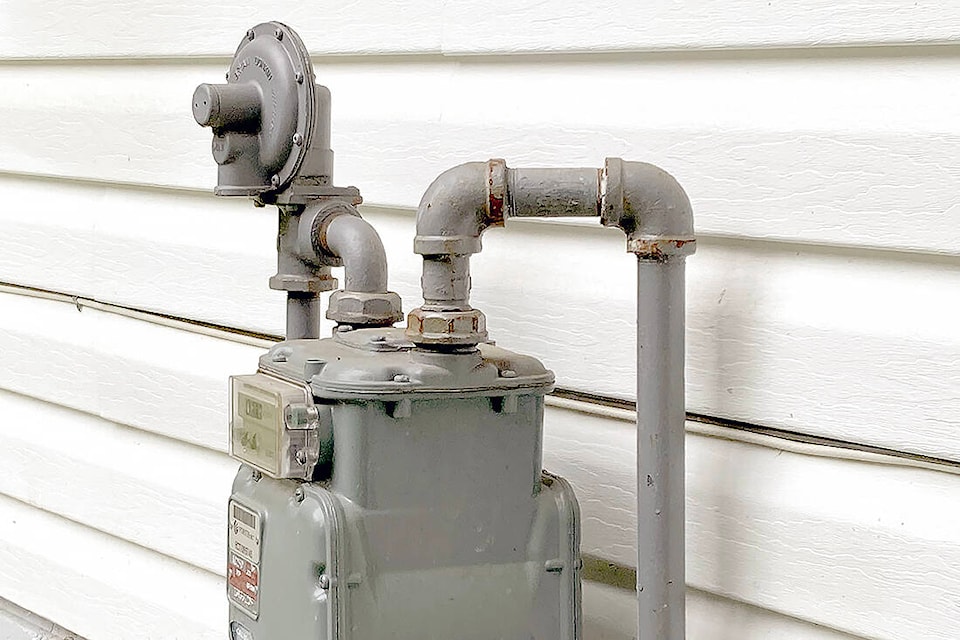Nanaimo’s next city plan will include long-term environmental goals, and councillors may be faced with some decisions about how home energy choices will fit with those goals.
The draft city plan’s accompanying draft action plan includes advocacy for a provincewide moratorium on new natural gas connections, and there was further discussion of the issue at a council meeting this week. On Monday, April 25, council heard three delegations arguing for and against continued natural gas use.
Jason Wolfe, director of energy solutions with Fortis B.C., told councillors about the utility’s short-term and long-term intentions to increase the percentage of renewable natural gas used provincewide.
Renewable natural gas, he said, is bio-methane that comes from farms, landfills, wastewater treatment plants, wood waste and curbside organics. Currently, he said, just one per cent of Fortis’ natural gas supply is renewable, but by the end of 2024, the utility anticipates 18 million gigajoules per year will be generated.
“That’s the equivalent amount of renewable natural gas to heat over 300,00 homes or, as another comparison, about the same amount of energy that would be put out by Site C in one year, or any other large dam,” Wolfe said.
Fortis’ target is to increase the natural gas supply to 47 per cent by 2030 and 75-100 per cent by 2050.
There are no renewable natural gas operations currently on-stream on Vancouver Island. Wolfe said one project is in the works in the Capital Regional District, but noted that any renewable natural gas that enters other parts of Fortis’ system essentially displaces conventional natural gas for use elsewhere.
Coun. Tyler Brown asked if local governments’ waste-diversion efforts would impact the availability of waste needed for renewable natural gas production, and Wolfe replied that Fortis estimates an “upper-end potential” of 400 million gigajoules, well beyond the 230 million in the current system.
Coun. Ben Geselbracht said he questioned “the genuineness” of Fortis’ promotion of renewable natural gas.
“There’s been some criticism that with the amount of marketing that I’ve come across for renewable natural gas by Fortis, that it’s a big green-washing ploy to keep growing the customer base and locking in users and locking in the infrastructure so that people will still be dependent on [a] majority of conventional natural gas,” he said.
RELATED: City of Nanaimo draft plan calls for B.C.-wide moratorium on new natural gas connections
Following Fortis’ presentation, community members representing local environmental groups argued that it would be contrary to the city’s interests to continue to allow natural gas connections in new buildings.
“Our targets are laudable, but we must make policy for low-carbon emission systems in new buildings now,” said Brian Short, a member of First Unitarian Fellowship of Nanaimo’s environment committee.
Shelley Serebrin, a member of the Nanaimo Climate Action Hub, asked council if the city can meet its emissions-reduction targets considering population growth.
“Thousands of new residential and commercial units are projected to be built,” she said. “We then have a great opportunity at the municipal level to wean new households and businesses off fossil fuels.”
Also arguing against natural gas was Deborah Curry, a sub-committee member with the B.C. Division of the Canadian Association of Physicians for the Environment. She said renewable natural gas comes in the same pipes as fracked gas, and said as with conventional natural gas, is more harmful to the environment than carbon dioxide when it leaks and creates CO2 when it burns. She said gas hookups needs to be removed to reduce emissions and health risks caused by climate change.
“The heat dome this summer was devastating, but we are still producing methane and carbon as a society and if we do not act boldly and swiftly in decreasing our emissions, the health costs of climate change will escalate,” Curry said.
Council did not make any motion related to the discussion. Councillors are expected to further discuss the city plan and related action plan during a series of meetings in May.
READ ALSO: Renewable natural gas boom coming, advocates say, as companies turn waste into fuel
editor@nanaimobulletin.com
Like us on Facebook and follow us on Twitter
